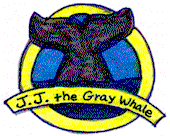
he "J.J.'s Adventure" website has a lot to offer educationally.
At the end of each of the "Gray Whales," "Rescue," and "Recovery" sections there is an interactive quiz. First, have the students read the section. Then have the students take the quiz either by clicking on the "quiz" text link at the end of the section, or by clicking on the "quiz button" at the bottom of the title banner. Students select their answer by clicking on the round button in front of the answer they think is right. They may change their answers at any time. At the end of the quiz, students submit the quiz by clicking on the "submit" button, and instantly their score appears! They may take the quiz as many times as they like.
Also, each of the "Gray Whales," "Rescue," and "Recovery" sections has a short section with additional links to whale resources on the Internet.
Each blue underlined word in the text of the "Gray Whales," "Rescue," and "Recovery" sections leads to the glossary.
In the "Activities" section, there are three fun activities that will get students involved with whale information.
"Word Search"
It's probably best to print out the "Word Search" beforehand. Then have the students try to search out the words at the bottom of the page. If you email Leah at leah@tikipub.com with a brief message and request, we will email the answer key to you as an attached image file.
"Diving with J.J."
This is a simple and fun activity that requires few materials but illustrates one way that ocean organisms move about under the sea. Some of you may recognize the activity as the "Cartesian Diver." You may use any size plastic soda bottle but we have found that the two-liter size works nicely.
"Anatomy Puzzle"
It's probably best to print this page first before having students work on this one. In doing this activity, students click on the underlined "clue" link to go out on the Internet and find the answers that fit in the blanks. They may have to read a web page or so about whales to find the right answer. Then they write the correct term in the blanks on the printed sheet. When the bold underlined letters in the words are lined up over each other, they spell a "secret message" which is, by the way, "helpwhales."
In the "Visitors" section, students are encouraged to interact with the site and add to it.
"Comments"
This is a guestbook area that allows students to add their remarks to a growing list of messages from kids. Here students can leave their own thoughts about whales, any questions, or reactions to the web project. Comments that are submitted are automatically added to the previous messages and students can instantly view their additions. We will periodically "clean" out any unnecessary or inappropriate messages.
"Poetry"
Poetry is one neat and personal way for students to express their reactions to whales. Students are encouraged to write a poem about whales and submit it. It will instantly be added to the growing number of whale poems on the list.
"Art"
Drawing and painting is another way for students to express their reactions to whales. Here, if students mail in their art about whales, drawings, paintings, etc. to the address provided, we will scan and post the art in the gallery on this page.
In the "Authors" section, students learn about the three girl authors and may email them if they have questions or comments.
Found in the "Rescue" section, there is a link to an interview with Dr. Tom Reidarson, staff veterinarian at SeaWorld. It might be interesting to students to read how someone becomes a veterinarian and eventually works at SeaWorld.
Found at the end of the "Recovery" section, the link to the latest about J.J. the Whale at SeaWorld will connect students with the latest official information about the whereabouts and condition of J.J. the Whale. This promises to be a very interesting ongoing look into what happens to J.J. after she is released. Stay tuned and check back often.
Have fun!
J.J. logo © 1997 SeaWorld, Inc. All rights reserved. Used with permission. |